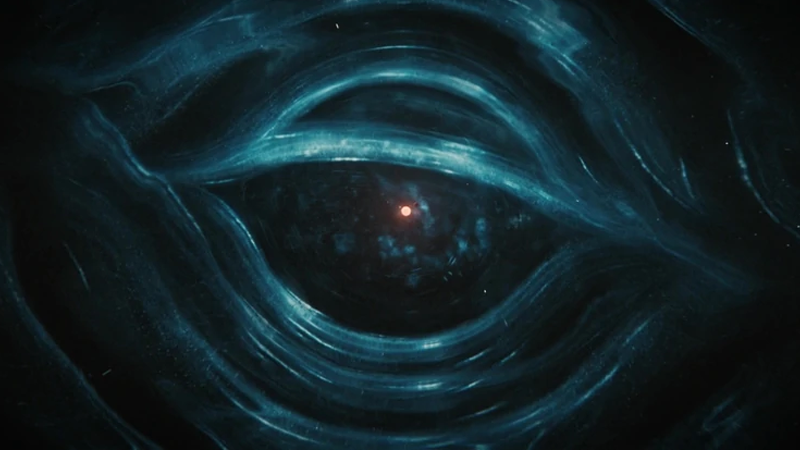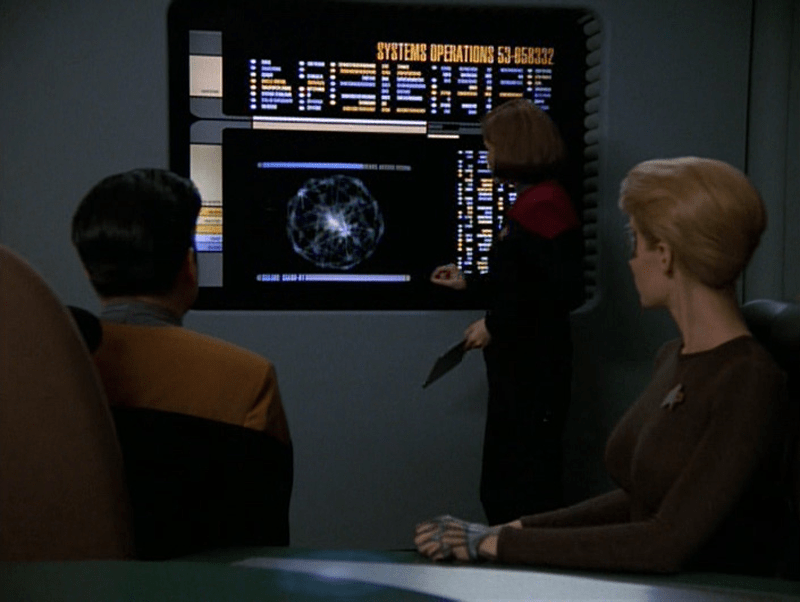As Star Trek: Discovery’s fourth season builds up to its endgame pitching the Federation into a dangerous first contact with a mysterious, extra-galactic threat, at the heart of it all has been a mysterious, planet-wrecking anomaly known as the DMA. But as we’ve learned more about the anomaly, it’s revealed a surprising connection to Star Trek: Voyager — and a threat that could have major ramifications for the Star Trek universe.

What Is Star Trek: Discovery’s Dark Matter Anomaly?
In the past few weeks since Discovery returned from its mid-season hiatus, we and the crew of the the titular vessel have come to learn more and more about what the “Dark Matter Anomaly” actually is. Early in the season, we discovered that the anomaly isn’t actually anomalous at all, and instead a manufactured tool being used by a mysterious species from beyond the galactic barrier, currently only known to the Federation by the designation “10-C.” It turns out that the anomaly isn’t a weapon of war, even if its appearance in the Star Trek galaxy has brought with it gravitic waves powerful enough to tear planets near to the teleporting, massive storm apart wherever it finds itself travelling. It’s actually a highly advanced mining tool, and it’s being used to harvest an incredibly rare element with a name familiar to diehard Trek fans: boronite.

What is Boronite, and Why Is It Important?
Boronite was first introduced in the 1998, season-four Star Trek: Voyager episode “The Omega Directive.” An element that only naturally formed in incredibly small quantities across the known universe, boronite was a key component in synthesizing an incredibly powerful molecule known only as the Omega molecule. Omega molecules were theorised to be capable of storing incredibly vast amounts of energy — at the time of Voyager’s setting in the late 24th century, the Federation believed a single molecule contained the equivalent energy of a fully powered starship warp core, and even small chains of Omega could provide energy to entire civilizations for generations.
Omega’s big problem was that it was also almost impossible to keep in a stabilised state for any period of time. Experiments with Omega in secret by Federation scientists in the 23rd century were able to synthesise a single molecule that destabilized in an instant, and did so violently. Not only did the ensuing explosion destroy the research station the experiment was conducted aboard, killing hundreds of people, the real threat of Omega was revealed to have lasting implications beyond the immediate explosive aftermath of destabilization. Omega’s destruction left a tear in the fabric of subspace in its wake, a rupture that, even from the fallout of a single molecule’s destabilization, stretched lightyears from the the origin point of the explosion. The rupture in subspace prevented conventional warp travel technology — the creation of a stable bubble to allow for safe FTL travel — from being used, and with the rupture seemingly irreparable, warp travel in the aftermath of an Omega detonation became impossible seemingly forever.
In the wake of its tragic research on the molecule, the Federation immediately enacted a cover-up, classifying the subspace rupture as a natural phenomenon, and made the very existence of Omega molecules a classified secret known only to Starfleet ship captains and other high-ranking flag officers in the organisation. Known as the Omega Directive, the general Starfleet order overrode even the organisations’ most vaunted rule, the Prime Directive, and tasked Starfleet captains with the authority to destroy a detected Omega molecule by any means necessary. Omega, as rare as it was, represented the greatest threat to the Federation imaginable — if even a handful of molecules were synthesized and destabilized, the damage to subspace rendering long-range communication and warp travel impossible could end spacefaring civilisation as the Federation and most known species perceived it forever.

What Could Omega Molecules Mean for Star Trek’s Future?
If Species 10-C is mining what rare natural instances of boronite are even available in the known galaxy, there’s a good chance they might have done what no civilisation in the Federation, or even beyond it, has ever been able to: create a sustainable energy source from properly stabilised Omega molecules. Even in the advanced future of the 31st century that Discovery has found itself set in since the climax of season two, such a revelation would reflect one of the greatest leaps in technological capability Star Trek has seen from its usual 22nd-24th century settings in other series. Even beyond all the other technological advances we’ve seen in Discovery’s recent seasons, it’d be one of the few reveals to really hit long time fans with a show of just how far things have come — even if that technology is still even wildly beyond the capacity of the Federation in that time.
But the inherent power of Omega molecules, if that is what 10-C are using their mined boronite for, could be implemented just as destructively, too. If the Federation’s first contact with the species goes bad — and it might, considering last week rogue scientist Ruon Tarka destroyed the first DMA with a very illegal weapon — weaponised Omega could do untold damage to the Federation and the galaxy at large. Beyond just the potency of its energy release, Omega’s ability to destabilize subspace could plunge the Federation into a dark age even worse than the effects of the Burn — which, at the very least, was an non-permanent barrier to most warp travel, and some degree of communication was still available across vast passages of space. Widespread detonation of Omega molecules could cut off the civilizations of the galaxy from each other forever, effectively bringing an end to the Federation as an entity in the process.
Whatever happens as Discovery’s fourth season enters its endgame, drawing on a 24 year old plot thread from Voyager — and extrapolating the potential horror of its worst outcome — is one hell of a thing to hang a season on. With Seven of Nine on Picard, Kate Mulgrew’s Janeway returned in animated form on Star Trek: Prodigy, and now this, it feels like Voyager is getting a moment in the spotlight in Trek’s current, bright future.
